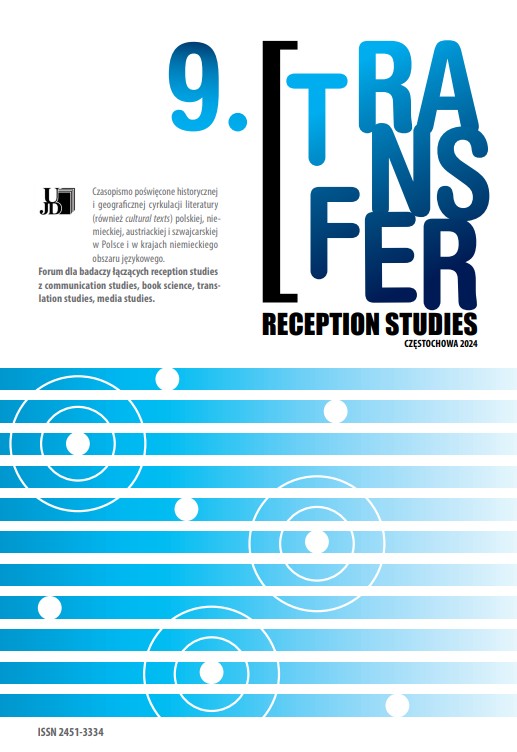Translational Problems in Audio Description. The Case Study of “Django Unchained” by Quentin Tarantino
Abstract
The main purpose of this paper is to discuss the most common translational problems which occur during the production of audio description (AD), which is one of the modes of audiovisual translation (AVT). The article analyses selected translational problems encountered while scrutinizing the film entitled Django Unchained (2012) by Quentin Tarantino. The analysis is chiefly focused on issues which occur most frequently in the film and seem to be most difficult to solve by audio describers, both in English and in Polish versions of the film. The study compares notions of character description, facial expressions and gestures; these phenomena constitute in fact the core of audio description and particular attention should be paid to accurate rendering of them into the target language. Nonetheless, the article suggests possible strategies of dealing with the above-mentioned obstacles. Proceeding from these considerations, the study proposes conclusions concerning the type of audio description that would probably be the most successful and beneficent to the target audience.
Supporting Agencies
Keywords:
audio description, audiovisual translation, Django Unchained, Quentin TarantinoReferences
References
Benecke, Bernard. “Character fixation and character description. The naming and describing of characters in Inglorious Basterds.” In Audio Description. New Perspectives Illustrated, edited by Anna Maszerowska, Anna Matamala, and Pilar Orero, 141–150. Amsterdam / Philadelphia: John Benjamins Publishing Company, 2014. https://doi.org/10.1075/btl.112.09ben. Google Scholar
Fryer, Louise. An Introduction to Audio Description. A Practical Guide. Lon-don and New York: Routledge, 2016. https://doi.org/10.4324/9781315707228. Google Scholar
Matsumoto David, and Bob Willingham. “Spontaneous Facial Expressions of Emotion of Congenitally and Noncongenitally Blind Individual.” Journal of personality and social psychology 96, no. 1 (2009). https://www.apa. Google Scholar
org/pubs/journals/releases/psp9611.pdf. Google Scholar
Mazur, Iwona. “Gestures and Facial Expression in Audio Description.” In Audio Description. New Perspectives Illustrated, edited by Anna Maszerowska, Anna Matamala, and Pilar Orero, 179–197. Amsterdam / Philadelphia: John Benjamins Publishing Company, 2014. https://doi.org/10.1075/btl.112.11maz. Google Scholar
Perego, Elisa. “Audio description. Evolving recommendations for usable, effective and enjoyable practices.” In The Routledge Handbook of Audi-ovisual Translation, edited by Luis Pérez-González, 114–129. London / New York: Routledge, 2019. https://doi.org/10.4324/9781315717166 . Google Scholar
Szarkowska, Agnieszka, and Pilar Orero. “The importance of Sound for Audio Description.” In Audio Description. New Perspectives Illustrated, edited by Anna Maszerowska, Anna Matamala, and Pilar Orero, 121–139. Amsterdam / Philadelphia: John Benjamins Publishing Company, 2014. https://doi.org/10.1075/btl.112.08sza. Google Scholar
Szymańska Barbara, and Tomasz Strzymiński. „Audiodeskrypcja. Obraz słowem malowany. Standardy tworzenia audiodeskrypcji do produkcji audiowizualnych,” [Audiodescription. Painting in words], accessed April 20, 2013. http://avt.ils.uw.edu.pl/en/publikacje/. Google Scholar
Filmography Google Scholar
Django Unchained, director Quentin Tarantino, cinematography Robert Richardson, USA, 2012. Google Scholar
Statistics
Abstract views: 131PDF downloads: 99
Similar Articles
- Anna Bednarczyk, Reception, or What? Adaptive Translation in the Context of Politics (Between Citation and Plagiarism) , Transfer. Reception Studies: Vol. 9 (2024): The Literature (of the) “now.” Interventions, Trends and Revisions
- Katarzyna LUKAS, Border Crossings in Intersemiotic Translation: the Graphic Novel Heimsuchung und andere Erzählungen von Bruno Schulz by Dieter Jüdt , Transfer. Reception Studies: Vol. 3 (2018)
- Markus EBERHARTER, Alexander Batowski's Criticism of the Polish Translation of Friedrich Schiller's Poem, Die Ideale , Transfer. Reception Studies: Vol. 2 (2017)
- Aleksandra JACKIEWICZ, In search of a reaffirmation of one’s own poetic voice through translation: contemporary Polish poetry translated into Spanish , Transfer. Reception Studies: Vol. 3 (2018)
- Marta KAŹMIERCZAK, What Can the Intertextual Paradigm Yield to Translation Studies - An East European Perspective , Transfer. Reception Studies: Vol. 2 (2017)
- Edyta Manasterska-Wiącek, Is the Russian Luna the Same as Polish Księżyc? Sense and Nonsense in Translation and Reception of Grammatical Gender , Transfer. Reception Studies: Vol. 9 (2024): The Literature (of the) “now.” Interventions, Trends and Revisions
- Anna Mach, The Role of Intersemiotic Elements in Song Translation: A Case Study of Coin-Operated Boy, Performed by The Dresden Dolls* , Transfer. Reception Studies: Vol. 9 (2024): The Literature (of the) “now.” Interventions, Trends and Revisions
- Karolina MATUSZEWSKA, „To get out of the shade, wardrobe and cellar" - an international literary translation programme „TransStar Europa" and its influence over the reception of German- -speaking literature of the 20st and the 21st centuries in Poland , Transfer. Reception Studies: Vol. 1 (2016): CIRCULATION OF GERMAN-LANGUAGE AND POLISH LITERATURE IN THE XXI CENTURY
- Andrew C. Rouse, László Réthy, Árpád Lőwy’s Permissive Piggery (Disznólkodni szabad) Translated by Andrew C. ROUSE , Transfer. Reception Studies: Vol. 9 (2024): The Literature (of the) “now.” Interventions, Trends and Revisions
- Katarzyna Janus, Poems by Benedict Schwalbe (ca. 1460–1521) on the Annunciation to Anna and Joachim, the Immaculate Conception and the Birth of Mary. Translation and Explication , Transfer. Reception Studies: Vol. 9 (2024): The Literature (of the) “now.” Interventions, Trends and Revisions
You may also start an advanced similarity search for this article.

